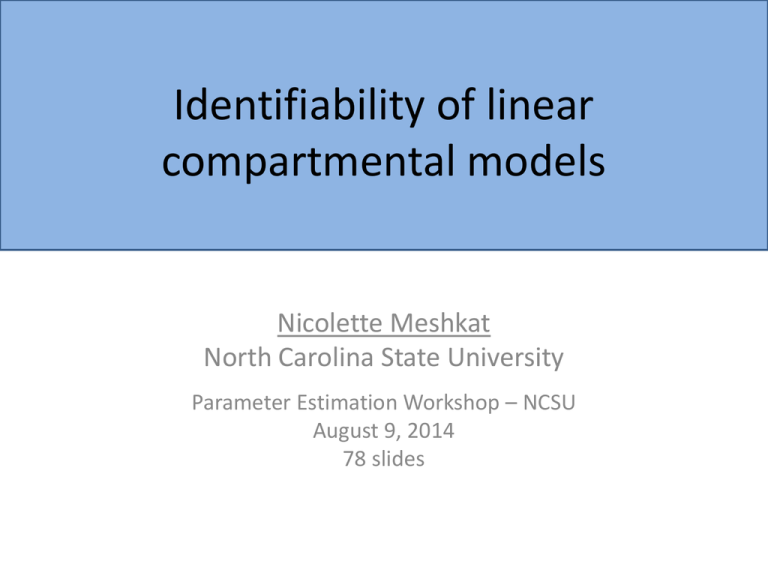Model
advertisement

Identifiability of linear
compartmental models
Nicolette Meshkat
North Carolina State University
Parameter Estimation Workshop – NCSU
August 9, 2014
78 slides
Structural Identifiability Analysis
• Linear Model:
–
–
–
–
state variable
input
output
matrices with unknown parameters
• Finding which unknown parameters of a
model can be quantified from given inputoutput data
But why linear compartment models?
• Used in many biological applications, e.g.
pharmacokinetics
• Very often unidentifiable!
• Nice algebraic structure
– Can actually prove some general results!
Unidentifiable Models
• Question 1: Can we always “reparametrize” an
unidentifiable model into an identifiable one?
Motivation: Question 1
• Model 1:
• Model 2:
Motivation: Question 1
• Model 1: No ID scaling reparametrization!
• Model 2: ID scaling reparametrization:
Unidentifiable Models
• Question 1: Can we always “reparametrize” an
unidentifiable into an identifiable one?
• Question 2: If a reparametrization exists, can
we instead modify the original model to make
it identifiable?
Motivation: Question 2
• Model 2:
• Starting with Model 2, how should we adjust model
to obtain identifiability?
– Decrease # of parameters?
– Add input/output data?
Motivation: biological models
Measured drug
concentration
Drug
input
Drug exchange
Loss from blood
Loss from organ
y
u1
Example: Linear 2Compartment Model
k21
x1
k01
k12
x2
k02
Linear Compartment Models
• System equations:
• Can change to form
Larger class of models to investigate
• Assumptions:
– I/O in first compartment
– Leaks from every compartment
where
and diagonal elements =
Useful tool: Directed Graph
• A directed graph G is a set of:
– Vertices
– Edges
• Ex 1:
1
– Vertices: {1, 2}
– Edges: {1 2, 2 1}
2
Useful tool: Directed Graph
• A directed graph G is a set of:
– Vertices
– Edges
• Ex 2:
1
2
3
– Vertices: {1, 2, 3}
– Edges: {1 2, 2 1, 2 3}
• A graph is strongly connected if there exists a
path from each vertex to every other vertex
Useful tool: Directed Graph
• A directed graph G is a set of:
– Vertices
– Edges
• Ex 3:
1
2
3
– Vertices: {1, 2, 3}
– Edges: {1 2, 2 1, 2 3, 3 1}
• A graph is strongly connected if there exists a
path from each vertex to every other vertex
Convert to graph
• Let G be directed graph with m edges, n vertices
• Associate a matrix A to the graph G:
where each
is an independent real parameter
• Look only at strongly connected graphs
2-compartment model as graph
Model:
Graph:
1
• Cycle:
• “Self” cycles:
2
Identifiability Analysis
• Model:
• Unknown parameters:
• Identifiability: Which parameters of model can
be quantified from given input-output data?
– Must first determine input-output equation
Find Input-Output Equation
• Rewrite system eqns as
• Cramer’s Rule:
• I/O eqn:
Identifiability
• Can recover coefficients from data
• Identifiability: is it possible to recover the
parameters of the original system, from the
coefficients of I/O eqn?
– Two sets of parameter values yield same
coefficient values?
– Is coeff map 1-to-1?
2-compartment model
• I/O eqn
• Coefficient map
• Identifiability: Is the coefficient map 1-to-1?
No!
Identifiability from I/O eqns
• Question of injectivity of the coefficient map
• If c is one-to-one: globally identifiable
finite-to-one: locally identifiable
infinite-to-one: unidentifiable
One-to-one Example
• Map
• 2 equations:
• One-to-one:
Finite-to-one Example
• Map
• 2 equations:
• Finite-to-one:
or
Our example
• 3 equations:
• Infinite-to-one!
Our example
• 3 equations:
• Infinite-to-one!
Testing identifiability in practice
• Check dimension of image of coefficient map
• If dim im c = m+n, then locally identifiable
• If dim im c < m+n, then unidentifiable
• Linear Ex:
• Jacobian has rank 2:
Testing identifiability in practice
• Check dimension of image of coefficient map
• If dim im c = m+n, then locally identifiable
• If dim im c < m+n, then unidentifiable
• Our Ex:
• Jacobian has rank 3:
Unidentifiable models
• Cannot determine individual parameters, but
can we determine some combination of the
parameters?
Ex:
or
• A function
from c if
is called identifiable
Identifiable functions
• Coefficients:
• Identifiable functions (cycles):
• Coefficients can be written in terms of
identifiable functions:
Unidentifiable model
• Model
• Identifiable functions
i.e.
• Reparametrize: 4 independent parameters
3 independent parameters?
Identifiable reparametrization
Let
be a coefficient map
An identifiable reparametrization of a model
is a map
such that:
•
•
has the same image as
is identifiable (finite-to-one)
Scaling reparametrization
• Choice of functions
we replace
• Set
since
• Since model is
is replaced with
where
with
is observed
, each parameter
• Only graphs with at most 2n-2 edges
Reparametrize original model
• Use scaling:
• Re-write:
• Map
has same image as
and is 1-to-1
Motivation: Unidentifiable models
• Model 1: No ID scaling reparametrization!
2
1
3
• Model 2: ID scaling reparametrization:
2
1
3
Main question:
Which graphs with 2n-2 edges admit
an identifiable scaling reparametrization?
Main result 1 :
Let G be a strongly connected graph. Then TFAE:
The model has an identifiable scaling
reparametrization
The model has an identifiable scaling
reparametrization by monomial functions of
the original parameters
All the monomial cycles in G are identifiable
functions
dim im c = m+1
1 N.
Meshkat and S. Sullivant, Identifiable reparametrizations of linear compartment models, Journal of Symbolic
Computation 63 (2014) 46-67.
Non-Example: Model 1
2
1
3
Model:
dim im c = 4, so no ID scaling reparametrization!
Example: Model 2
2
1
Model:
Identifiable cycles:
3
Algorithm to find identifiable
reparametrization
1) Form a spanning tree T
2) Form the directed incidence matrix E(T):
3) Let E be E(T) with first row removed
4) Columns of E-1 are exponent vectors of
monomials
in scaling
Identifiable reparametrization
2
• Spanning tree
1
3
• Rescaling:
• Identifiable scaling reparametrization
Main result
• A model with
– I/O in first compartment
– n leaks
– Strongly connected graph G
has an identifiable scaling reparametrization
all the monomial cycles are identifiable
dim im c = m+1
Which graphs have this property?
• Inductively strongly connected graphs when
m=2n-2
2
3
2
3
Bad:
Good:
1
4
1
4
2
3
1
4
• Not complete characterization:
Unidentifiable Models
• Question 1: Can we always “reparametrize” an
unidentifiable into an identifiable one?
• Question 2: If a reparametrization exists, can
we instead modify the original model to make
it identifiable?
Model 2
2
1
•
•
•
•
3
Input/Output in compartment 1
Leaks from every compartment
dim im c = m+1 = 5
Identifiable cycles
Obtaining Identifiability
2
1
3
• Starting with Model 2, how should we adjust
model to obtain identifiability?
• Two options: Remove leaks or add input/output
Removing leaks
2
1
• Remove 2 leaks
• dim im c = 5
3
Theorem on Removing leaks 2
• Starting with a model with:
– I/O in first compartment
– n leaks
– Strongly connected graph G
– dim im c = m+1
• Remove n-1 leaks
Local identifiability
• Ex:
2 N.
2
3
1
4
Meshkat, S. Sullivant, and M. Eisenberg, Identifiability results for several classes of linear compartment models, In preparation.
Example: Manganese Model 3
3 P.
K. Douglas, M. S. Cohen, and J. J. DiStefano III, Chronic exposure to Mn inhalation may have lasting effects: A physiologically-based toxicokinetic model in rats, Toxicology and Environmental Chemistry 92 (2) (2010) 279-299.
Adding output to leak compartment
2
1
3
• Remove 1 leak and add 1 output to leak
compartment
• dim im c = 6
Thm: Removing leaks and adding inputs/outputs
• Starting with a model with:
–
–
–
–
I/O in first compartment
n leaks
Strongly connected graph G
dim im c = m+1
• Remove a subset of leaks so that every leak compartment has
either input or output
Local identifiability
• Ex:
2
3
1
4
Sufficient, not necessary
• Harder to find general conditions if I/O not in
leak compartment
Identifiable
Not identifiable
2
1
2
3
1
3
Quiz!
• Which of the following models are
identifiable?
1
2
(A)
• Answer: B and C
1
2
(B)
1
2
(C)
Identifiability Problem for Nonlinear
Models
• What is our model is nonlinear?
• Same process:
– Find I/O equations
– Test injectivity of coefficient map
Identifiability Problem for Nonlinear
Models
• What is our model is nonlinear?
• Same process:
– Find I/O equations
– Test injectivity of coefficient map
y
u
Example: Nonlinear
2-Compartment
Model
k21
x1
k12
x2
k02
Nonlinear 2-compartment model
• I/O eqn
Nonlinear 2-compartment model
• I/O eqn
• Globally identifiable
Nonlinear 2-compartment model
• I/O eqn
• Globally identifiable
Nonlinear 2-compartment model
• I/O eqn
• Globally identifiable
Nonlinear 2-compartment model
• I/O eqn
• Globally identifiable
Nonlinear 2-compartment model
• I/O eqn
• Globally identifiable
Nonlinear 2-compartment model
• I/O eqn
• Globally identifiable
Differential algebra
• How to find I/O equations for nonlinear
models?
• Differential elimination
– Differentiation + Gröbner Basis
– Differential Gröbner Basis
• Rosenfeld-Gröbner in Maple
– Ritt’s pseudo-division
Example on Lotka-Volterra
• Equations:
• Commands in Maple:
Example on Lotka-Volterra
• Equations:
• Rosenfeld-Gröbner gives:
Example: Nonlinear HIV Model 4
• Model equations:
• Parameter vector:
4 X.
Xia and C. H. Moog, Identifiability of nonlinear systems with application to
HIV/AIDS models, IEEE Trans Autom Contr 48 (2003), 330-336.
Input-Output equations
• Rosenfeld-Gröbner gives two equations:
• Coefficient map
– Unidentifiable!
How to find identifiable functions?
• Injectivity test: If
, does
?
• Amounts to solving a system of polynomial
equations
• Find Gröbner Basis of
– Gives system of equations
“triangular form”
in
• Analogous to Gaussian elimination for systems of linear
equations
– Must give an “ordering” of parameters to do the
elimination
Example of Gröbner Basis
• Set up
, for
b
d
s
b k2 q2
2
2
b k2 q2
c k1 m2 c m1 m2 b k2 q2 s
c k1 m1 m2
b k1 k2 q1 b d k2 q2 b k1 k2 q2 b k2 m1 q2
c k1 c m1 c m2 k1 m2 m1 m2
• Gröbner basis for
c
c
c
s
d
b
k2 q2
c2
c m2 m22
c
m2
q2
c
m2
c
m2
k1 q1
c q2
m2 q2
q2
k1 k2 q1
c
m2
c k1 m1 m2
c
q2
m2
Algorithm 5
• Find Gröbner Bases of
for
different orderings of the parameter vector
• Look for elements of the form
in
Gröbner Basis
• Implies
is identifiable
• Must find N identifiable functions in order to
reparametrize, where N = dim im c
5 N.
Meshkat, M. Eisenberg, and J. J DiStefano III, An algorithm for finding globally identifiable parameter
combinations of nonlinear ODE models using Groebner Bases, Math. Biosci. 222 (2009)
Examine Gröbner Bases
c
c
c
s
d
b
k2 q2
c2
c2
c k1
c m2 m22
k12
c m1 2 k1 m1
c
m2
c
m2
c
m2
q2
k1 q1
c q2
m2 q2
q2
k1 k2 q1
c
m2
c k1 m1 m2
m12
k1 m1
k1 m1
k1 m1
k1 m1
c
c k1 m1
c
s
d
b
k2 q2
q2
k1 q1 k1 q2 m1 q2 q2
k1 k2 q1
k1
m1
c k1 m1 m2
m2
q2
k1
m1
c
k1
m1
q2
m2
k12
2 k1 m1
m12
k1 m2 m1 m2
m22
m2
m2
k1 m1 m2 k1 m1 m2
c k1 m1 m2
s
d
b
k2 q2
q2
k1 q1 k1 q2 m1 q2
k1 k2 q1
k1
m1
c
k1
q2
m1
q2
m2
k1
m1
m2
Identifiable Functions
• ID parameters:
– Globally identifiable (one solution)
– Locally identifiable (three solutions)
• ID parameter combinations:
– Globally identifiable (one solution)
– Locally identifiable (three solutions)
Identifiable Reparametrization
• Identifiable:
• Use scaling:
Implementation: COMBOS
• Collaboration with Christine Kuo, Joe
DiStefano III (UCLA)
• Finds identifiable combinations for
unidentifiable models
• http://biocyb1.cs.ucla.edu/combos
Available software to test
identifiability
• Differential Algebra Methods:
– DAISY
• Available online at http://www.dei.unipd.it/~pia
– COMBOS
• Soon available at http://biocyb1.cs.ucla.edu/combos
• Other methods:
– GenSSI
• Available online at http://www.iim.csic.es/~genssi/
Acknowledgements
• Collaborators:
– Seth Sullivant (NCSU)
– Marisa Eisenberg (Univ. of Michigan)
– Joe DiStefano III (UCLA)
– Christine Kuo (Harvard)
Summary
• Nec. and suff. for identifiable scaling reparam
• Suff. conditions for obtaining identifiability
• Algorithm to find identifiable functions in
nonlinear models using Gröbner Bases
• COMBOS
Thank you for your attention!








